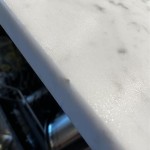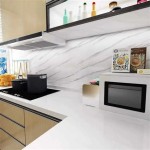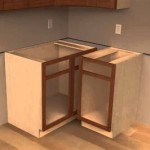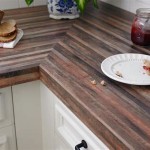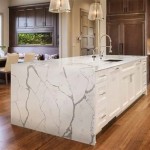How to Refinish Kitchen Countertops
Kitchen countertops endure considerable wear and tear. From food preparation to casual dining, these surfaces are constantly exposed to moisture, heat, scratches, and stains. Refinishing countertops provides a cost-effective alternative to complete replacement, offering an opportunity to update the kitchen's aesthetics and extend the lifespan of existing surfaces. A successful refinishing project requires careful planning, proper preparation, and the selection of appropriate materials. This article will provide a detailed guide on how to refinish kitchen countertops, covering essential steps and considerations for a professional-looking result.
Before commencing any refinishing project, it is crucial to assess the existing countertop material and its condition. Common countertop materials include laminate, solid surface (such as Corian), tile, and concrete. Each material presents unique challenges and requires specific refinishing techniques. Laminate countertops, for instance, can be refinished with paint or epoxy, while solid surface countertops can be sanded and polished. Tile countertops require grout repair and potential resealing. The extent of damage, such as deep scratches, chips, or stains, will also influence the chosen refinishing method and the level of preparation required.
Selecting the Right Refinishing Method
The choice of refinishing method hinges on several factors, notably the countertop material, the desired aesthetic outcome, and the budget. Several options are available, each with its own set of advantages and disadvantages.
Painting: Painting is a viable option for laminate and some solid surface countertops. It provides a relatively inexpensive way to change the color and appearance of the countertop. The process involves thorough cleaning, sanding to create a receptive surface, priming, and applying multiple coats of paint specifically designed for countertops. A protective topcoat is essential to enhance durability and resistance to scratches and stains. However, painted countertops may not be as resilient as other refinishing options and may require more frequent maintenance.
Epoxy Resin: Epoxy resin offers a more durable and visually appealing alternative to paint. Epoxy coatings create a seamless, glossy surface that is resistant to heat, scratches, and stains. Epoxy can be tinted to any desired color and can also incorporate decorative elements like metallic pigments, glitter, or embedded objects. The application process involves mixing a two-part epoxy resin and hardener and pouring it evenly over the prepared countertop surface. Achieving a smooth, bubble-free finish requires careful attention to detail and may necessitate the use of a heat gun or torch to remove trapped air. Epoxy refinishing is generally more expensive than painting but provides a longer-lasting and more aesthetically pleasing result.
Concrete Overlay: For those seeking a more substantial transformation, a concrete overlay can be applied to existing countertops. This involves applying a thin layer of concrete mix over the existing surface, creating a new, durable countertop with a unique texture and appearance. Concrete overlays can be customized with various pigments, aggregates, and finishes. The application process requires expertise in concrete work, including proper mixing, application, and curing techniques. Concrete countertops are highly durable and heat-resistant but can be susceptible to staining if not properly sealed.
Tile Regrouting and Sealing: For tile countertops, refinishing primarily involves addressing the grout. Over time, grout can become stained, cracked, or deteriorated. Removing old grout and replacing it with fresh grout can significantly improve the appearance of the countertop. After regrouting, the entire surface should be thoroughly cleaned and sealed to protect the grout and tile from moisture and stains. Choose a grout that is stain-resistant and mold-resistant for optimal longevity.
Preparing the Countertop Surface
Proper surface preparation is paramount to achieving a successful and long-lasting refinishing result. Regardless of the chosen refinishing method, the following steps are essential:
Cleaning: Thoroughly clean the countertop surface with a degreasing cleaner to remove any dirt, grease, or grime. Pay particular attention to areas around the sink and stove, where grease and food residue tend to accumulate. Rinse thoroughly with clean water and allow the surface to dry completely.
Repairing Damage: Repair any chips, cracks, or scratches before proceeding with the refinishing process. Use a filler specifically designed for the countertop material. Apply the filler according to the manufacturer's instructions, allow it to dry completely, and then sand it smooth to blend seamlessly with the surrounding surface. For laminate countertops, use a laminate repair paste. For solid surface countertops, use a color-matched solid surface repair kit. For tile countertops, repair any broken or loose tiles and address any cracks in the grout.
Sanding: Sanding is crucial for creating a receptive surface for the new finish. For laminate countertops, use a medium-grit sandpaper (120-150 grit) to lightly scuff the surface. For solid surface countertops, start with a coarser grit sandpaper (80-100 grit) to remove any imperfections and then gradually move to finer grits (120-150 grit, followed by 220 grit) to create a smooth surface. For tile countertops, sanding is not typically required unless there are any rough edges or imperfections on the tile surface. Dust thoroughly after sanding with a tack cloth or vacuum cleaner.
Priming: Applying a primer is essential for ensuring proper adhesion of the new finish. Choose a primer that is specifically designed for the countertop material and the chosen refinishing product. Apply the primer in thin, even coats, following the manufacturer's instructions. Allow the primer to dry completely before proceeding to the next step. For laminate countertops, use an adhesive primer. For solid surface countertops, use a bonding primer. For tile countertops, a primer may not be necessary unless the grout is porous.
Masking: Protect surrounding surfaces, such as cabinets, walls, and appliances, with painter's tape and drop cloths. This will prevent accidental spills or splatters during the refinishing process. Pay particular attention to areas around the sink, stove, and backsplash.
Applying the New Finish
The application of the new finish requires careful attention to detail and adherence to the manufacturer's instructions. Whether painting, applying epoxy, or using a concrete overlay, the following guidelines are essential:
Painting: Apply multiple thin coats of paint, allowing each coat to dry completely before applying the next. Use a high-quality brush or roller designed for the type of paint being used. Avoid applying thick coats, as this can lead to drips and uneven coverage. Sand lightly between coats with fine-grit sandpaper (220 grit) to create a smooth finish. Apply a protective topcoat to enhance durability and resistance to scratches and stains. Choose a topcoat that is specifically designed for countertops and is resistant to water, heat, and chemicals.
Epoxy Resin: Mix the epoxy resin and hardener according to the manufacturer's instructions. Pour the mixture evenly over the prepared countertop surface, starting from one end and working your way to the other. Use a squeegee or spreader to distribute the epoxy evenly. Use a heat gun or torch to remove any trapped air bubbles. Work quickly, as epoxy resin has a limited working time. Allow the epoxy to cure completely according to the manufacturer's instructions. This may take several days. Avoid placing any objects on the countertop until the epoxy is fully cured.
Concrete Overlay: Mix the concrete overlay material according to the manufacturer's instructions. Apply the mixture to the prepared countertop surface using a trowel or spatula. Work in small sections and feather the edges to create a seamless transition. Use a concrete finishing tool to smooth and compact the surface. Allow the concrete to cure completely according to the manufacturer's instructions. This may take several days. Seal the concrete countertop with a concrete sealer to protect it from stains and moisture. Apply multiple coats of sealer, allowing each coat to dry completely before applying the next.
Tile Regrouting and Sealing: After removing the old grout and preparing the tile, apply new grout according to the manufacturer's instructions. Use a grout float to press the grout into the joints and remove excess grout. Wipe the tile surface with a damp sponge to remove any remaining grout haze. Allow the grout to cure completely according to the manufacturer's instructions. Seal the grout with a grout sealer to protect it from moisture and stains. Apply multiple coats of sealer, allowing each coat to dry completely before applying the next. Ensure the sealer is specifically designed for grout and is water-resistant and stain-resistant.
Refinishing kitchen countertops is a project that combines practical skills with detailed execution. By carefully selecting the appropriate refinishing method, meticulously preparing the surface, and applying the new finish with precision, it is possible to achieve a rejuvenated and aesthetically pleasing countertop that enhances the value and appeal of the kitchen.

How To Refinish Kitchen Countertops Family Handyman

Diy Kitchen Countertop Makeover

Countertop Refinishing Refinish Your Counter Tops Miracle Method
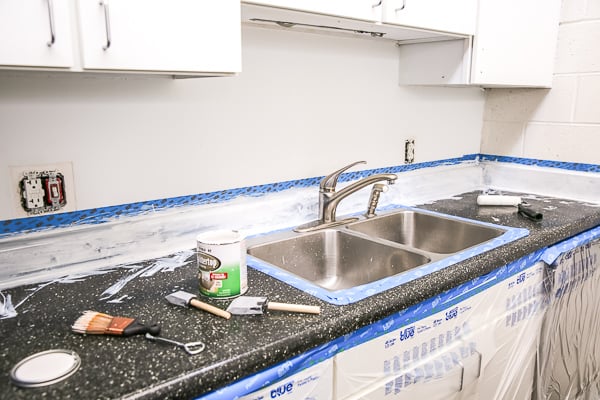
Easy How To Resurface Laminate Countertops For Under 50

Countertop Refinishing Refinish Your Counter Tops Miracle Method

How To Resurface Laminate Countertops Bob Vila

Change The Color Of Laminate Countertops Without Replacing Them

How To Refinish A Butcher Block Island Or Countertop Youtube

How To Paint Laminate Counter Tops

How To Refinish Laminate Counters Made By Marzipan

